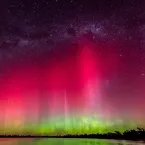Our Research
As climate changes, how do Earth's frozen areas affect our planet and impact society?
In this section
Related News & Stories
Filter by:

Analysis - Sea Ice Today
Since 2007, the Arctic sea ice minimum has dropped below 5 million square kilometers (1.93 million square miles) every year, except in 2009, 2013, and 2014, when extent barely crossed the 5 million square kilometer mark. Such low extents would have been hard to imagine in the 1990s, when extent averaged 6.46 million square kilometers (2.49 million square miles). Arctic climate warming continues to lead an unfortunate path of change for the planet. Here, NSIDC researchers summarize this year’s events in the Arctic, and touch upon Antarctica sea ice extent at the end of its austral winter.

News Release
Antarctic sea ice has likely reached its maximum extent for the year, at 17.16 million square kilometers (6.63 million square miles) on September 19, according to scientists at the National Snow and Ice Data Center (NSIDC) at the University of Colorado Boulder (CU Boulder). The 2024 maximum is the second lowest in the 46-year satellite record.

Spotlight
Software engineer and metadata architect Julia Collins discusses how she came to NSIDC, and how she came to appreciate the crucial value of data about data.

News Release
Arctic sea ice has likely reached its minimum extent for the year, at 4.28 million square kilometers (1.65 million square miles) on September 11, 2024, according to scientists at the National Snow and Ice Data Center (NSIDC) at the University of Colorado Boulder. The 2024 minimum is ranked seventh lowest in the 46-year satellite record.

Analysis - Sea Ice Today
On September 11, Arctic sea ice likely reached its annual minimum extent of 4.28 million square kilometers (1.65 million square miles). The 2024 minimum is the seventh lowest in the nearly 46-year satellite record. The last 18 years, from 2007 to 2024, are the lowest 18 sea ice extents in the satellite record.

Spotlight
In May 2024, our planet experienced one of the strongest solar storms in decades. The most visible (and fun) consequence of the solar storm was a proliferation of auroras. But solar storms pose risks to satellites, including NASA’s Ice, Cloud and land Elevation Satellite-2 (ICESat-2) which saw its normal operations interrupted.